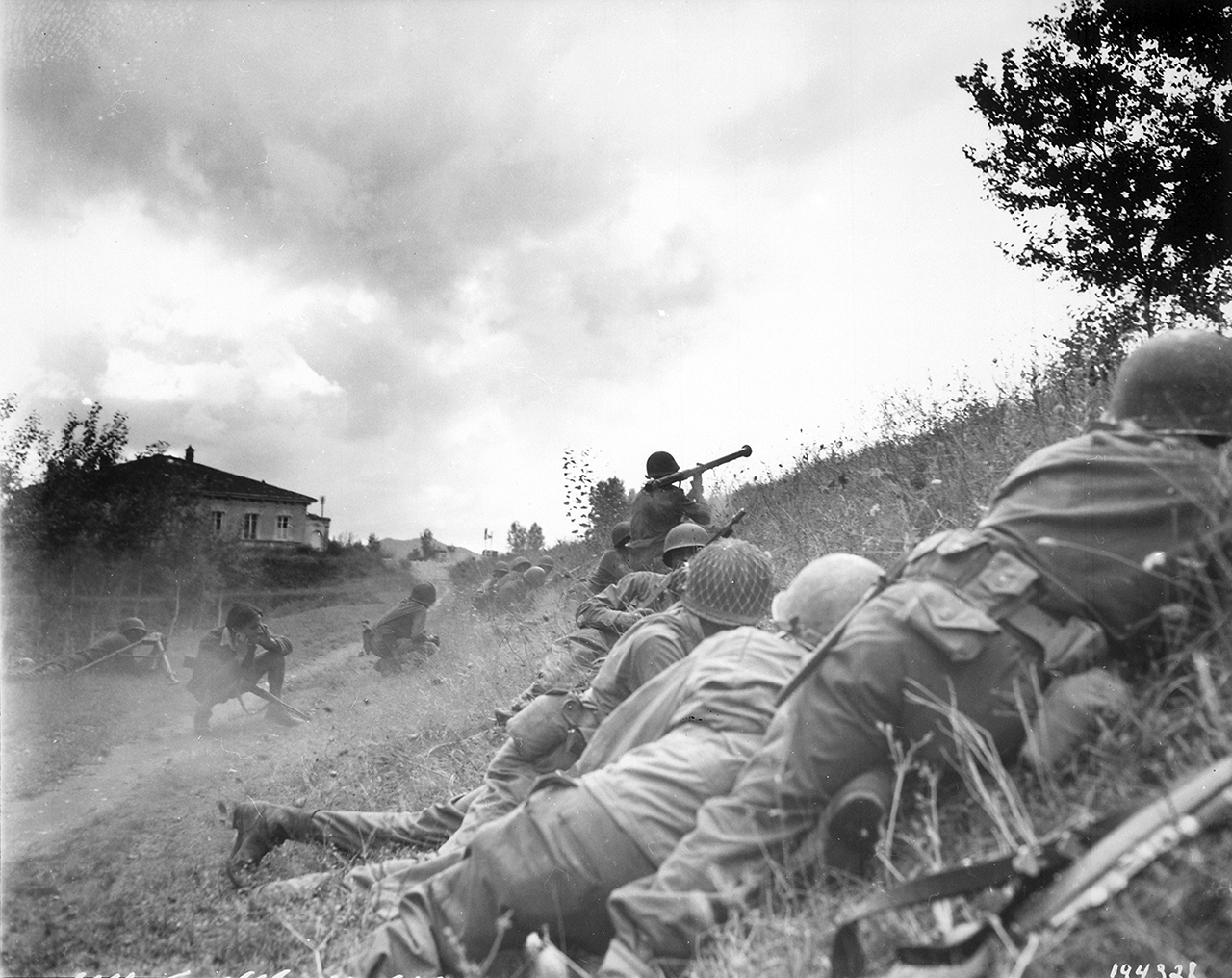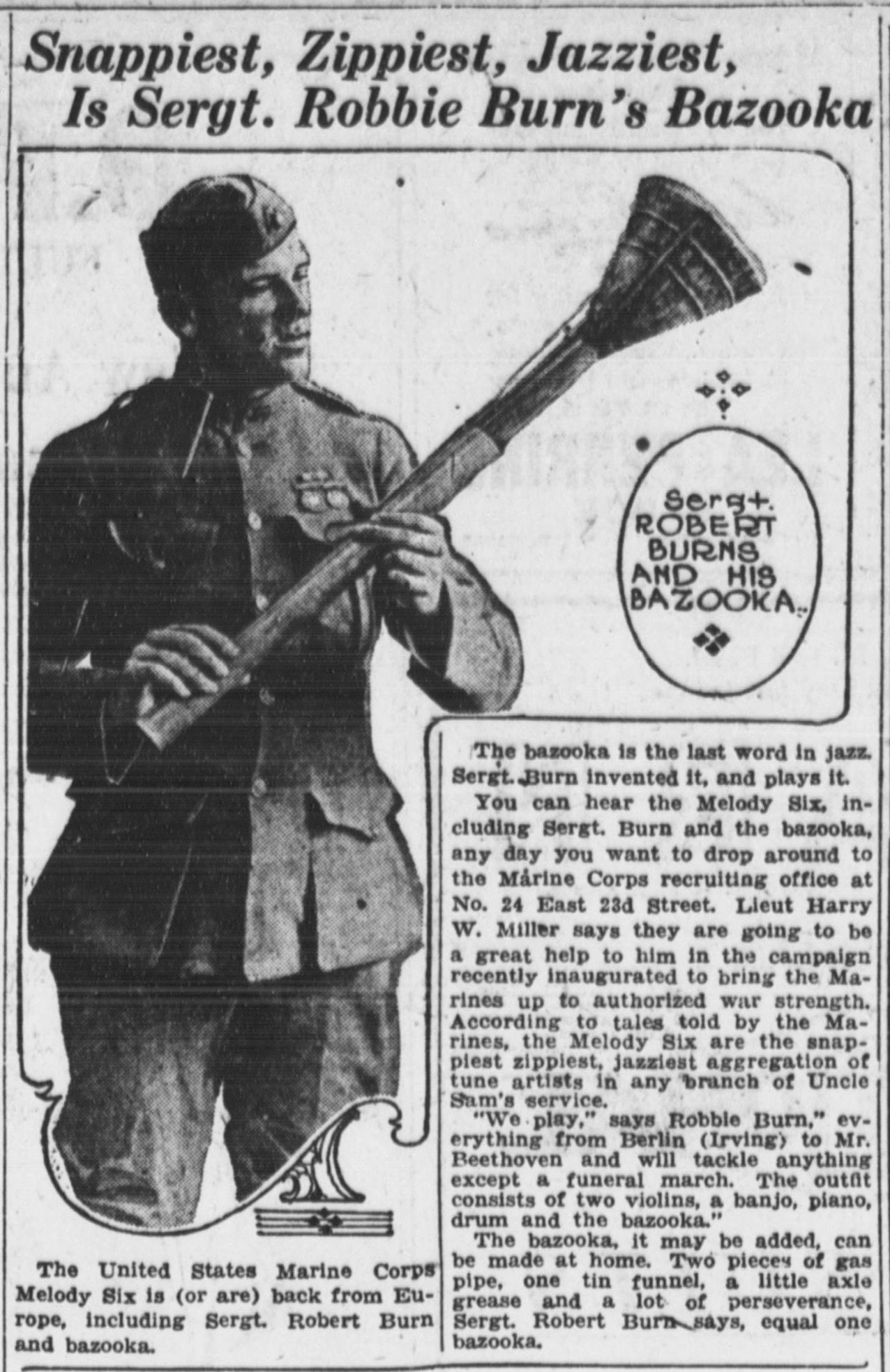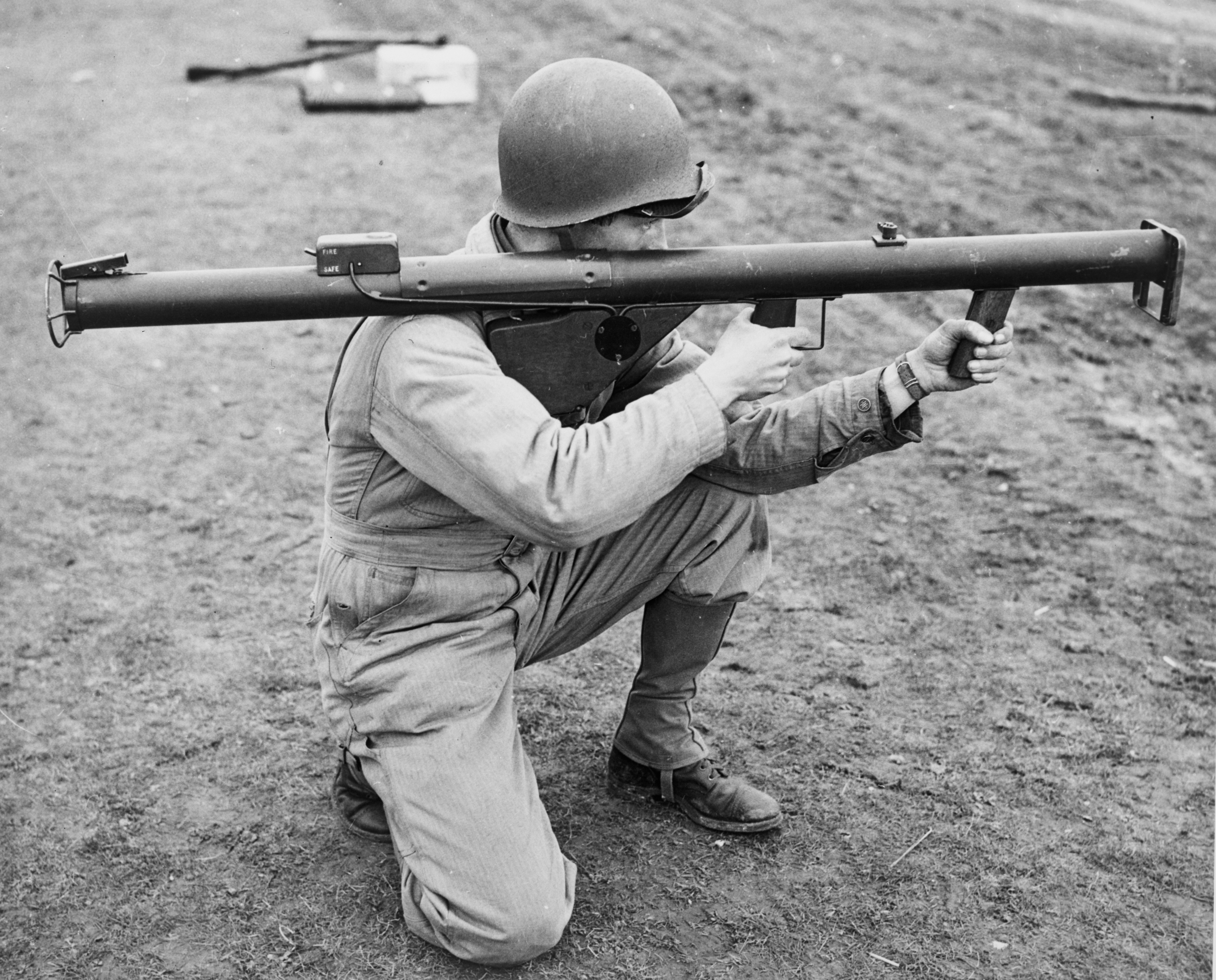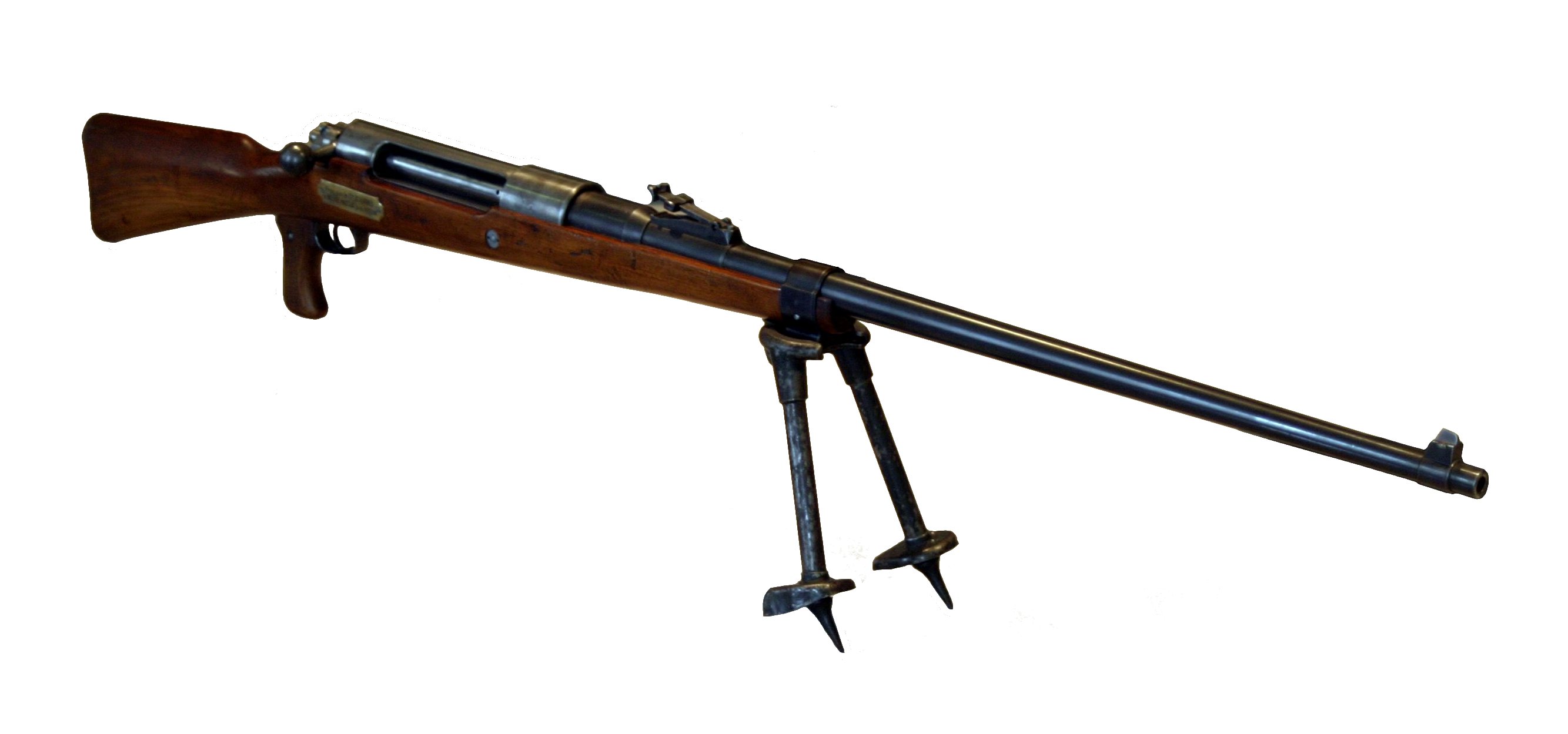 |
Bazooka
Bazooka () is the common name for a man-portable recoilless anti-tank rocket launcher weapon, widely deployed by the United States Army, especially during World War II. Also referred to as the "stovepipe", the innovative bazooka was among the first generation of rocket-propelled anti-tank weapons used in infantry combat. Featuring a solid-propellant rocket for propulsion, it allowed for high-explosive anti-tank (HEAT) warheads to be delivered against armored vehicles, machine gun nests, and fortified bunkers at ranges beyond that of a standard thrown grenade or mine. The universally applied nickname arose from the M1 variant's vague resemblance to the musical instrument called a " bazooka" invented and popularized by 1930s American comedian Bob Burns. During World War II, the German armed forces captured several bazookas in early North African and Eastern Front encounters and soon reverse engineered their own version, increasing the warhead diameter to 8.8 cm ( ... [...More Info...] [...Related Items...] OR: [Wikipedia] [Google] [Baidu] |
 |
Bob Burns (humorist)
Robin "Bob" Burns (August 2, 1890 – February 2, 1956) was an American musical comedian, who appeared on radio and in movies from 1930 to 1947. Burns played a novelty musical instrument of his own invention, which he called a "Bazooka (instrument), bazooka". During World War II, the US Army's bazooka, handheld anti-tank rocket launcher was nicknamed the "bazooka". Early years He was born Robin Burn in Greenwood, Arkansas. When he was three years old, his family moved to Van Buren, Arkansas. As a boy, Burns played trombone and cornet in the town's "Queen City Silver Cornet Band". At 13, he formed his own string band. Bob Burns hometown tribute Practicing in the back of Hayman's Plumbing Shop one night, he picked up a length of gas pipe and blew into it, creating an unusual sound. With modifications, this became bazooka (inst ... [...More Info...] [...Related Items...] OR: [Wikipedia] [Google] [Baidu] |
 |
Bazooka (instrument)
The bazooka is a brass musical instrument several feet in length which incorporates telescopic tubing like the trombone. Radio comedian Bob Burns is credited with inventing the instrument in the 1910s, and popularized it in the 1930s. It was also played by jazz musicians Noon Johnson and Sanford Kendrick. Sound From its start within a lipreed mouthpiece – which may consist of nothing but the bare tube or may employ a mouthpiece which is handmade to emulate one from a low brass instrument – the air column expands into a wide length of pipe that slides freely around a narrower length of pipe, which, in turn, terminates in a widely flaring bell. Although the slide action of the bazooka appears to alter pitch, this is not the case due to the extremely wide diameter of the horn's tubing. Manipulating the horn's length changes tone quality as subtle harmonic overtones fluctuate. This effect gives the bazooka its characteristic warbling, echoing sound. All of the bazooka' ... [...More Info...] [...Related Items...] OR: [Wikipedia] [Google] [Baidu] |
 |
Panzerschreck
''Panzerschreck'' (lit. "tank fright", "tank's fright" or "tank's bane") was the popular name for the ''Raketenpanzerbüchse'' 54 ("Rocket Anti-armor Rifle Model 54", abbreviated to RPzB 54), an 88 mm reusable anti-tank rocket launcher developed by Nazi Germany in World War II. Another earlier, official name was ''Ofenrohr'' ("stove pipe"). The ''Panzerschreck'' was designed as a lightweight infantry anti-tank weapon and was an enlarged copy of the American bazooka. The weapon was shoulder-launched and fired a fin-stabilized rocket with a shaped-charge warhead. It was made in smaller numbers than the '' Panzerfaust'', which was a light, disposable anti-tank weapon that used a system not unlike those of recoilless rifles. History The ''Panzerschreck'' development was initially based on the American " bazooka", captured during the Tunisian campaign, November 1942. The ''Panzerschreck'' was larger and heavier than its American counterpart – the ''Panzerschreck'' ha ... [...More Info...] [...Related Items...] OR: [Wikipedia] [Google] [Baidu] |
 |
Edward Uhl
Edward Uhl (March 24, 1918 – May 9, 2010) was a United States Army Ordnance Corps officer who developed the M1 portable rocket launcher, known as the bazooka. He was born in New Jersey and graduated in engineering at Lehigh University, Bethlehem, Pennsylvania in 1940. He enlisted in the US Army in 1941 and was commissioned into the Ordnance Corps. In 1942 while working at the headquarters of the corps in Washington with the rank of lieutenant he was tasked with utilizing the M1 shaped charge as an anti-tank weapon for use by the infantry. It was too heavy for a hand grenade so Uhl used a piece of scrap metal tubing to create a simple recoilless rocket launcher to propel the charge. According to Uhl, By launching from the shoulder the danger of burns to the face of the operator was avoided. In 1942 the new weapon was deployed to North Africa and it was later used effectively against German tanks in the Normandy Campaign. Uhl rose to the rank of lieutenant colonel ... [...More Info...] [...Related Items...] OR: [Wikipedia] [Google] [Baidu] |
 |
Anti-tank Warfare
Anti-tank warfare originated from the need to develop technology and tactics to destroy tanks during World War I. Since the Triple Entente deployed the first tanks in 1916, the German Empire developed the first anti-tank weapons. The first developed anti-tank weapon was a scaled-up bolt-action rifle, the Mauser 1918 T-Gewehr, that fired a 13mm cartridge with a solid bullet that could penetrate the thin armor of tanks of the time and destroy the engine or ricochet inside, killing occupants. Because tanks represent an enemy's strong force projection on land, military strategists have incorporated anti-tank warfare into the doctrine of nearly every combat service since. The most predominant anti-tank weapons at the start of World War II in 1939 included the tank-mounted gun, anti-tank guns and anti-tank grenades used by the infantry, and ground-attack aircraft. Anti-tank warfare evolved rapidly during World War II, leading to the inclusion of infantry-portable weapons su ... [...More Info...] [...Related Items...] OR: [Wikipedia] [Google] [Baidu] |
 |
Man-portable Anti-tank Systems
Man-portable anti-tank systems (MANPATS or MPATS) are traditionally portable shoulder-launched projectile systems firing heavy shell-type projectiles (although throwing and lunge weapons have existed), typically designed to combat protected targets, such as armoured vehicles, field fortifications and at times even low-flying aircraft (especially helicopters). MPATS-launchers can be either unguided or guided weapons and generally fall into three distinct categories: *''Disposable systems'', consisting of a small pre-loaded, single-shot launch tube meant to be disposed after firing, operated by one soldier. Examples include: Panzerfaust 1, M72 LAW, Miniman, AT4, FGM-148 Javelin, NLAW, etc. *''Reusable systems'', consisting of a reloadable firing system onto/into which a rocket or cartridge is loaded, operated by one or two soldiers. Examples include: Bazooka, Panzerschreck, Carl Gustaf 8.4 cm recoilless rifle, RPG-7, Panzerfaust 2, etc. *''Semi-disposable systems'', where the ... [...More Info...] [...Related Items...] OR: [Wikipedia] [Google] [Baidu] |
 |
Reverse Engineering
Reverse engineering (also known as backwards engineering or back engineering) is a process or method through which one attempts to understand through deductive reasoning how a previously made device, process, system, or piece of software accomplishes a task with very little (if any) insight into exactly how it does so. It is essentially the process of opening up or dissecting a system to see how it works, in order to duplicate or enhance it. Depending on the system under consideration and the technologies employed, the knowledge gained during reverse engineering can help with repurposing obsolete objects, doing security analysis, or learning how something works. Although the process is specific to the object on which it is being performed, all reverse engineering processes consist of three basic steps: Information extraction, Modeling, and Review. Information extraction refers to the practice of gathering all relevant information for performing the operation. Modeling refers to th ... [...More Info...] [...Related Items...] OR: [Wikipedia] [Google] [Baidu] |
 |
Bay Of Pigs Invasion
The Bay of Pigs Invasion (, sometimes called ''Invasión de Playa Girón'' or ''Batalla de Playa Girón'' after the Playa Girón) was a failed military landing operation on the southwestern coast of Cuba in 1961 by Cuban exiles, covertly financed and directed by the United States. It was aimed at overthrowing Fidel Castro's communist government. The operation took place at the height of the Cold War, and its failure influenced relations between Cuba, the United States, and the Soviet Union. In December 1958, American ally General Fulgencio Batista was deposed by Castro's 26th of July Movement during the Cuban Revolution. Castro nationalized American businesses—including banks, oil refineries, and sugar and coffee plantations—then severed Cuba's formerly close relations with the United States and reached out to its Cold War rival, the Soviet Union. The Central Intelligence Agency (CIA) began planning the overthrow of Castro, which U.S. President Dwight D. Eisenhowe ... [...More Info...] [...Related Items...] OR: [Wikipedia] [Google] [Baidu] |
 |
Rocket Launcher
A rocket launcher is a weapon that launches an unguided, rocket-propelled projectile. History The earliest rocket launchers documented in imperial China consisted of arrows modified by the attachment of a rocket motor to the shaft a few inches behind the arrowhead. The rocket was propelled by the burning of the black powder in the motor; these should not be confused with early fire arrows, which were conventional arrows carrying small tubes of black powder as an incendiary that ignited only after the arrow hit its target. The rocket launchers were constructed of wood, basketry, and bamboo tubes. The launchers divided the rockets with frames meant to keep them separated, and the launchers were capable of firing multiple rockets at once. Textual evidence and illustrations of various early rocket launchers are found in the 1510 edition of the '' Wujing Zongyao'' translated by Needham and others at Princeton University. (The original ''Wujing Zongyao'' was compiled between ... [...More Info...] [...Related Items...] OR: [Wikipedia] [Google] [Baidu] |
 |
World War II
World War II or the Second World War, often abbreviated as WWII or WW2, was a world war that lasted from 1939 to 1945. It involved the World War II by country, vast majority of the world's countries—including all of the great powers—forming two opposing military alliances: the Allies of World War II, Allies and the Axis powers. World War II was a total war that directly involved more than 100 million Military personnel, personnel from more than 30 countries. The major participants in the war threw their entire economic, industrial, and scientific capabilities behind the war effort, blurring the distinction between civilian and military resources. Air warfare of World War II, Aircraft played a major role in the conflict, enabling the strategic bombing of population centres and deploying the Atomic bombings of Hiroshima and Nagasaki, only two nuclear weapons ever used in war. World War II was by far the List of wars by death toll, deadliest conflict in hu ... [...More Info...] [...Related Items...] OR: [Wikipedia] [Google] [Baidu] |
 |
Machine Gun
A machine gun is a fully automatic, rifled autoloading firearm designed for sustained direct fire with rifle cartridges. Other automatic firearms such as automatic shotguns and automatic rifles (including assault rifles and battle rifles) are typically designed more for firing short bursts rather than continuous firepower, and are not considered true machine guns. As a class of military kinetic projectile weapon, machine guns are designed to be mainly used as infantry support weapons and generally used when attached to a bipod or tripod, a fixed mount or a heavy weapons platform for stability against recoils. Many machine guns also use belt feeding and open bolt operation, features not normally found on other infantry firearms. Machine guns can be further categorized as light machine guns, medium machine guns, heavy machine guns, general purpose machine guns and squad automatic weapons. Similar automatic firearms of caliber or more are classified as aut ... [...More Info...] [...Related Items...] OR: [Wikipedia] [Google] [Baidu] |
 |
Bunker
A bunker is a defensive military fortification designed to protect people and valued materials from falling bombs, artillery, or other attacks. Bunkers are almost always underground, in contrast to blockhouses which are mostly above ground. They were used extensively in World War I, World War II, and the Cold War for weapons facilities, command and control centers, and storage facilities. Bunkers can also be used as protection from tornadoes. Trench bunkers are small concrete structures, partly dug into the ground. Many artillery installations, especially for coastal artillery, have historically been protected by extensive bunker systems. Typical industrial bunkers include mining sites, food storage areas, dumps for materials, data storage, and sometimes living quarters. When a house is purpose-built with a bunker, the normal location is a reinforced below-ground bathroom with fiber-reinforced plastic shells. Bunkers deflect the blast wave from nearby explosions to prevent ... [...More Info...] [...Related Items...] OR: [Wikipedia] [Google] [Baidu] |